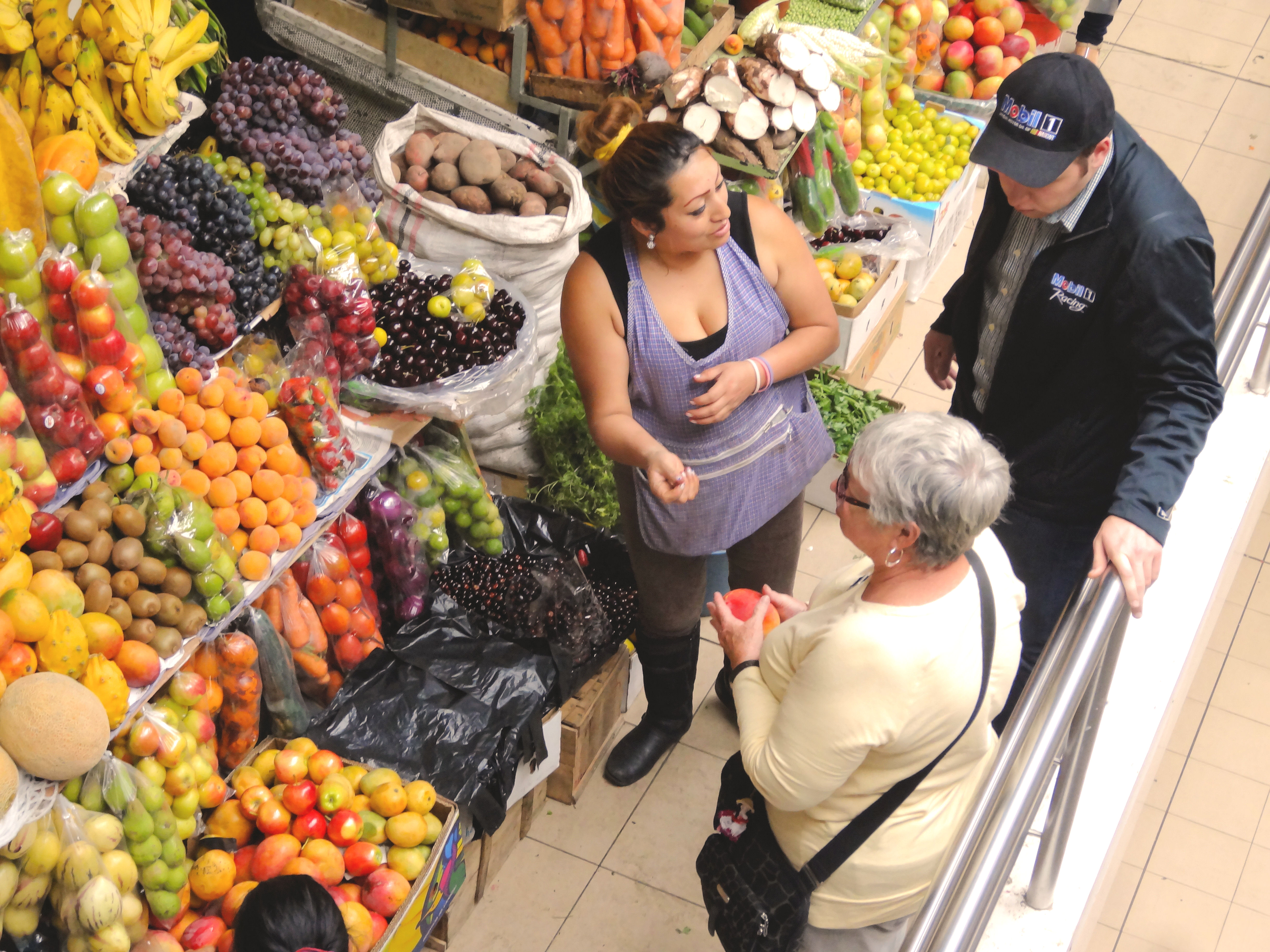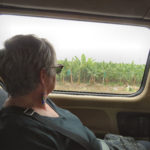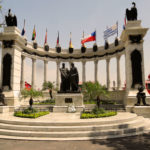Unbelievable weather in Dublin again. Gorgeous sun, mild breezes and breathtaking scenery describe the day. We left Dublin early in the morning and drove through the Wicklow Mountains the largest national park in Ireland. I promptly feel asleep and missed probably one of Ireland’s great treasures. My apologies to an animated guide and the Irish Chamber of Commerce. Leaving the park we encounter more agriculture. Sheep, sheep and more sheep, dairy farming and hay farming. This is one of the richest farming areas of Ireland and the goal of every Irishman at one time was to marry a girl from the area. . This is also horse country and we were treated to a sighting of some special falabella miniature horses that are bred in this area. Because of their size they are hard to spot. Luckily we saw five. The potato famine was brought home to us when when were shown a famine house that a wealthy landowner gave to three peasant families. Because of this they were able to survive the starving time. Ireland lost roughly a third of its population to death and this was also the time of the great diaspora to the US and Canada. The Irish feel as strongly about the famine as Jews do the Holocaust. The English landowners did nothing to prevent so much suffering. On a happier note we visited Glendalough a former monastic site. Remains of the chapter house, a round tower and two beautiful lakes and sheep and more sheep and deer nosing backpacks completed that visit. There were about two hundred secondary school girls visiting the site. Brought back many memories. Teen age girls are universal creatures full of giggles and squeals. These uniformed beauties had no cell phones however. On to Kilkenny where we opted for a pub meal of Irish steak and roast with Yorkshire pudding and veggies. We loved the village and the medieval castle. But sometimes you just want to eat and people watch. Back to Dublin and tomorrow we head for Scotland. Another land, another currency and another culture.
Author: Sally Knight
More and Moher
Today’s adventure was Moher than expected. We drove out of Dublin into the Irish countryside which is dotted with sheep, dairy cattle, and picturesque farmhouses. The shades of green are absolutely boundless and the twisting country lanes can barely accommodate the tour bus. Everyone makes room for everyone. No worries seems to be the motto of drivers. No rude gestures or threatening weapons. The Cliffs of Moher rise above the Atlantic Ocean accepting all of the power the ocean has to give. Seabirds soar above and the occasional whale makes an appearance. Alas not today. The fossil covered pathway up to the cliffs is a history of life from ages and ages past. The cliffs are a part of the Wild Atlantic Way which we loved. On one side the ocean, on the other side more farms. Thatched roofs, lace curtains, dahlias, asters, rudbeckia, petunias, pansies and geraniums in their full glory decorate gardens and window boxes. Lunch in Galway was fresh oysters, slices of salmon, crab and smoked mackerel, and of course an Irish ale. This is one of the oldest cities in Ireland. Norman invaders taught these uncivilized Irish organization, trading, and civil responsibility. The Lynch family from the middle ages led the Irish into a changing word. Well done Normans and Mr. Lynch. We made our way back to the bus through musicians, artist, and visitors from all over the world happy to have seen a different side of Ireland.
State and Church in Dublin
After coffee and croissants, Troy and I crossed the Ha penny Bridge and make our way to the Dublin Castle which still serves as the site for state dinners, presidential inaugurals and anything of importance to Ireland or Dublin. A member of the Easter Rebellion was housed there until his injuries healed enough so that he could be executed. Expect he did not want many get well soon wishes. Queen Victoria and Prince Albert visited the castle and she complained that the throne provided her was too tall. Queen Elizabeth II visited during her Golden Jubilee and I am sure she was too gracious to complain about anything. Plaster work, wood work, carpets and paintings are gorgeous and say much about the craftsman of Ireland. A visit to St. Patrick’s finished up our day. The adjacent park was full of dog owners and students enjoying a warm sunny September day. The Cathedral a tribute to Christianity and the devotion of the Irish people. A children’s choir school is housed next door to the cathedral and they perform weekly for the public. Pretty cool to go to a school established over 600 years ago.
Sailing the Irish Sea
Left London and the delightful Hotel Z and set out for Dublin, Ireland.The taxi drive out of London took us along side St. James Park where ladies were riding well trained horses through the park and along Wimpole St. where the famous poetess Elizabeth Barrett once lived. The train trip through the English countryside and into Wales was beautiful. Lush green countryside dotted with sheep , cattle and horses was a change from city life. A uni student bought us a coffee and two ladies headed for a family reunion in Bangor were thoroughly entertaining by being understatedly witty. Farms gave way to mountains and the Irish Sea and we were in Wales ready to set sail for Dublin. The ferry ride took about 4 hours on a smooth sea. we snacked on sandwiches, drank Irish beer and people watched. Our taxi driver helped settle us into our apartment which is a very basic and has a mysterious system of switches that must be engaged to make the washer, shower and lights work. So far we have managed to wash our clothes, but have not figured out the shower. It ain’t easy in Ireland McGee. Our pantry is stocked with Irish bread, oranges, and wine. Survival items. Today we head to Dublin Castle and St. Patrick’s Church and an Irish Tea served on a bus. Details to follow.
The Road to Ingapirca
This was our last chance to make a road trip while in Cuenca. Tomorrow we have to finish up a little shopping and start packing to return to the States. Troy and I along with Thomas our grandson decided to go to Ingapirca one of the best preserved Canari and Incan sites in Ecuador. The bus station was not a mad house and we were able to purchase our tickets in no time and the round trip was only $21.00. Luckily we got assigned seats both ways because the bus was a pig trail and filled up with locals and all their goods quickly. We passed through Azogues a beautiful little city and Canari where the descendents of those ancient people still live. Men and women alike wear a round white hat with little tassels hanging from the front or the back. We can’t determine why some wear them one way and some another. The children also wear these little hats with their school uniforms. I am happy to see that they hold to many of their traditions.
The trip up the mountain was beautiful. We climbed another thousand feet and the valleys were home to little villages, Holstein cattle, sheep, pigs and chickens. Pampas grass was eight feet tall along side the road and Shasta daisies grown wild. No matter how poor the house there were geraniums or roses in the yard. Men and women worked in the field side by side. The wife wears her beautiful velvet skirt with a scalloped hem laden with brightly colored sequins. These ladies have a sturdy peasant body, but they are very feminine. Long gold earrings, beads and a lacy blouse are a part of their dress even when doing hard labor.
Ingarpica is a World Heritage Site and very well protected. Our guide spoke excellent English and gave us a good understanding of what society was like in this area. The Canari and Incans shared this spot, but working together they could not keep the Spanish away from their Empire. They were agricultural and had silos that stored two year’s supply of food. They had a trade route that went from Peru to Columbia and many believe in to North America. They were scientist who practiced astronomy, studied the moon to determine when to plant their crops, they were shepherds, weavers, and knew how to use precious metals. Instead of learning from them the Spanish destroyed every thing that they had accomplished. Thomas wisely observed that ISIS today is trying to do the same thing today. Destroying a culture.
 This is a twenty eight day calendar. The Incans would fill the holes with water and study the moons reflection each night. They began to understand the passage of time and used this calendar to plant their crops.
This is a twenty eight day calendar. The Incans would fill the holes with water and study the moons reflection each night. They began to understand the passage of time and used this calendar to plant their crops.
 The Canari and the Inca shared the site, but their building techniques were very different.
The Canari and the Inca shared the site, but their building techniques were very different.
The Canari structures were round and the Incan rectangular.
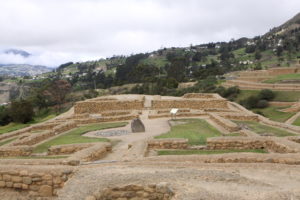 This is an Incan structure. These structures were storage buildings and shops. As we left the ruins, I looked out over the valley and saw the ghosts of these early people living their lives in a most idyllic manner under the arrival of the conquestidores.
This is an Incan structure. These structures were storage buildings and shops. As we left the ruins, I looked out over the valley and saw the ghosts of these early people living their lives in a most idyllic manner under the arrival of the conquestidores.
Grandson visit
Today we picked our grandson Thomas Knight up from the airport. He is going to visit us until we all return to the US. He is pretty exhausted from not sleeping since yesterday so we made a short loop around the main plaza, had lunch and visited the market. He had his first experience at haggling. He did ok on the fruit and really good with the hog head. He got it for $5.
And so Back to Cuenca
Guayaquil was a nice change. Luxurious sheets, well appointed room, Sangria brought from the bar and something besides Animal Planet on TV. We met a nice couple bicycling around the world who were staying in the hotel while she recovered from an accident and another couple at breakfast who were astounded that we had traveled on a bus. So the level of adventure does vary from traveler to traveler. We hired a driver to bring us back to Cuenca and I am not so sure we were any better off than on the bus, but the ride was beautiful if a bit scary. Leaving Guayaquil we were struck by the stark poverty that we saw in contrast to the natural beauty of the landscape. Dirty little towns and shacks sat along the road with open air restaurants were full of local resi ents eating lunch and drinking coffee. Their houses are little shacks on stilts each with one opening for a door and no windows. Some have new tin on the roof, but most the them have a rusty roof that would do little to protect the homeowner. A few scrawny chickens peck in the muddy dirt hunting for insects or worms. The people have no garden space to supplement their obviously poor diet. However, their native artistic sense is evident in their fruit stands. Mangoes, bananas, papaya, and watermelon are beautifully arranged on carts in a manner that best shows off the color and shape of the fruit. They are selling cut melons that were artful. We are always impressed by their merchandizing ability. They do not seem unhappy with their lives. They swim in the river have picnics by the water and play like children. Maybe the simple life suits them or they simply do not know any other way to live. The huge agribusiness fields are well tended and stretch as far as the eye can see while the smaller plots are worked by hand. I am sure many of the folks work for the agribusinesses when it is time to pick the crops. Small trucks loaded with bananas head west to Guayaquil to be sold to markets. We leave the flat lands and head up the mountain.
This is where the trip gets scary. The road is slick and curvy and we are soon in the clouds. The driver does not slow down. Troy tries to sleep so he can ignore this Mr. Toad’s Wild Ride. He does not sleep and I do not try. I think Manuelo believes that PILEGRO ZONA DERRUMBLES means drive like hell and no passing really meant TAKE OFF WHAT DO YOU HAVE TO LOSE. Honk the horn and everybody must get out of the way. WE stop for lunch which was chicken soup with a wing and a boiled egg in it which we bolt down and hit the road again. The scenery is gorgeous. Huge philodendron, ferns, lichen grow out of the mountain which constantly nourishes them with water and minerals. Lack of sun light means there are no flowers except for an occasional lupine. There is no sign of human activity until many miles later and then we sight small hotels, fishing camps and some ranching activity. This area is much more prosperous. There are garden plots, roses and Shasta daisies growing in the yard, children wear school uniforms and play alongside the road. Much of this area is CAJA NATIONAL PARK and the residents benefit from the park visitors. Soon Cuenca appears. This beautiful little jewel of a city nestles in the valley of four rivers. The Old Cathedral and the New Cathedral wait patiently for us. The maid did not come to the apartment as we wished but it doesn’t really matter.
Adios,
Sally
Guayaquil Hot and Humid
 Guayaquil is a tropical city and very different from Quito and Cuenca. We spent the morning in some very typical Texas weather. We visited Las Penas on the north end of the Malecon which represents the old Guayaquil. That area has been destroyed by fire, flood and faced an epidemic that killed thousands of its citizens. Las Penas is now an artist colony, boutique shopping area and a Bohemian settlement with some of the old wooden houses. They are built into the side of a hill almost on top of each other. They are pastel,and shuttered with interesting open design panesl to let in air. Some of the most famous Ecuadorian citizens had homes there. A fort protected Las Penas from invaders. I loved the interesting houses and the attempt to use them today.
Guayaquil is a tropical city and very different from Quito and Cuenca. We spent the morning in some very typical Texas weather. We visited Las Penas on the north end of the Malecon which represents the old Guayaquil. That area has been destroyed by fire, flood and faced an epidemic that killed thousands of its citizens. Las Penas is now an artist colony, boutique shopping area and a Bohemian settlement with some of the old wooden houses. They are built into the side of a hill almost on top of each other. They are pastel,and shuttered with interesting open design panesl to let in air. Some of the most famous Ecuadorian citizens had homes there. A fort protected Las Penas from invaders. I loved the interesting houses and the attempt to use them today.
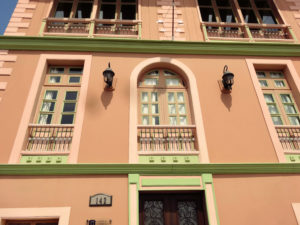

A giant Ferris Wheel slow turns along the Malecon giving the visitor a chance to see the old city and the new city and the busy river at the same time. Further down the Malecon there are beautiful gardens, a children’s playground a wide assortment of restaurants. The most beautiful statuary is of Simon Boliver and Jose de San Martin who worked to gain independence for countries in South America. We finished our sightseeing at the Museo Central which houses a number of pre Columbian artifacts and portraits of more Ecuadorian presidents that you would ever hope to see. Interestingly the museum is free, but they checked out passports and dutifully recorded the number in a dusty old notebook. Why we don’t know. In an attempt to cut down on crime there are volunteers about the city who wear a vest with the oxymoron “authorized vigilante” on the back. They watch parked cars, small parks and other public areas to make them safer.
On the Road to Quayaquil
Monday Morning, January 2 found us at the Terminal Terrestre hunting a bus to Guayaquil. We purchased our ticket just inside the terminal, saving ourselves .20 and having to fight through the turnstile. We also got assigned seats so if the bus filled up we would not get kicked off. For $17 we had a seat that would let us enjoy some of the most beautiful scenery in Ecuador. The route takes us through the upper part of Parque Cajas one of the many national parks in Ecuador. Along the road are beautiful trout streams and fields of the fattest dairy cattle ever. The bus climbs to the top of the mountain and llamas graze peacefully as they have done for centuries. Pristine volcanic lakes glimmer in the sunlight and every shade of green imaginable dots the mountainside relieved by huge boulders. WE see few people. Occasionally a farm house or two dot the country side. The route begins to descend the mountains and the landscape changes from rocks, lakes and trees to scattered banana plants. Locals stand beside the road trying to sell their fresh bananas. Suddenly as far as we can see there are banana plants with the full stalks of bananas wrapped in green plastic wrap to protect them from birds and other damage. On the opposite side of the road there are papaya plantations. The road is littered with dirty little towns that provide places for the plantation workers to live. Here it is evident that we are visiting a third world country. The towns consist of shacks that hardly seem livable, a number of cafes which are all full of people eating lunch and a sad little church or school. Children and adults swim in the swift moving river alongside the towns. Nothing much changes until we reach Duran, a small town on the outskirts of Guayaquil. Vendors appear with water bottles, rags to clean windshields and in some cases they break dance or juggle for a few pennies. I admire their optimism. About half the passengers leave the bus at Duran and the rest continue the journey. In about 30 minutes we reach Guayaquil bus station which is a mad house. We grasp our belongings and finally make our way through the terminal and find a taxi. A price is negotiated and we are soon at the Palace Hotel. Guayaquil is very different from Quito and Cuenca. It is not a colonial city and the buildings are modern and unimaginative. When we check in the handsome young clerk proudly points to the Iguana Park and tells us to watch out for iguana poop when we go. It is good advice. The hotel is lovely, a nice change for us and Troy is already looking for plane tickets to return to Cuenca on Thursday. The thought of that bus station is almost too much.
The New Year
 Dummies or Majotes decorate shop fronts, taxis, and private cars all over Cuenca. Most of them represent political figures and you can add your thoughts to their message board, some are cartoon characters, and some are more sophisticated displays created by an entire neighborhood. In the end they will be kicked to the curb and set on fire, symbolizing the end of the old year and what ever grief or despair that was there is now burned and a fresh slate awaits the New Year.
Dummies or Majotes decorate shop fronts, taxis, and private cars all over Cuenca. Most of them represent political figures and you can add your thoughts to their message board, some are cartoon characters, and some are more sophisticated displays created by an entire neighborhood. In the end they will be kicked to the curb and set on fire, symbolizing the end of the old year and what ever grief or despair that was there is now burned and a fresh slate awaits the New Year.


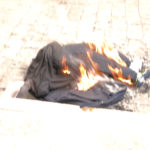

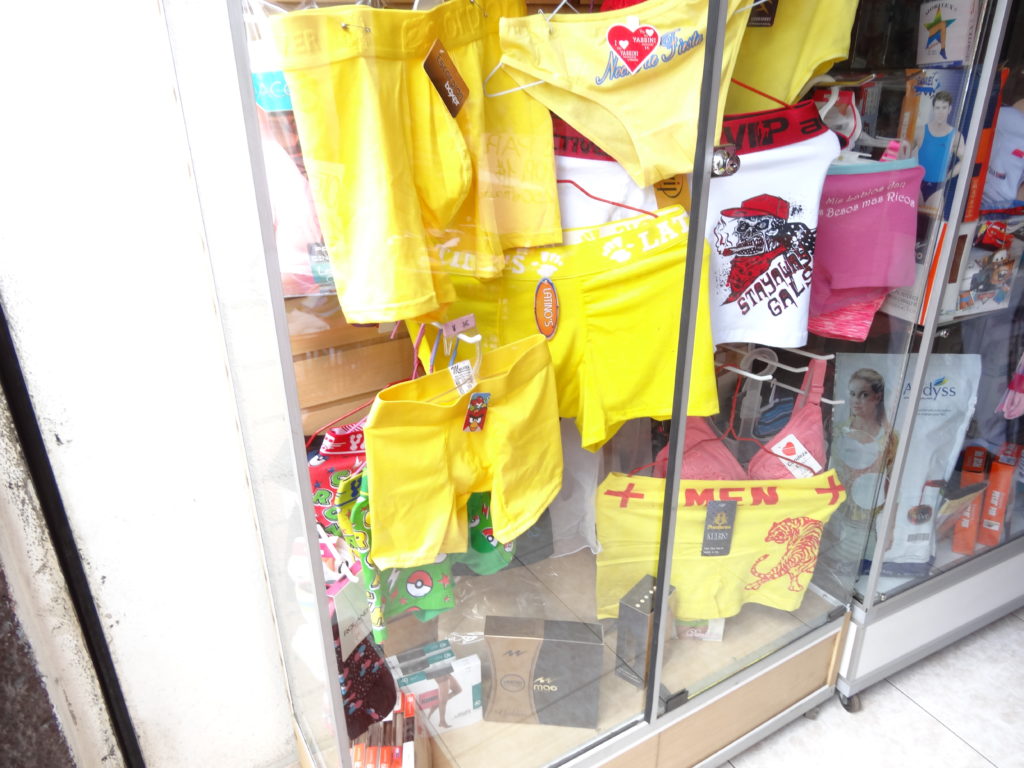 Yellow underwear for all genders and ages is worn for good luck, twelve grapes are consumed at midnight, young men dressed like Viajes or widows roam the neighborhood begging candy and pennies, and free beer stands are set up in the neighborhood. Who could ask for more.
Yellow underwear for all genders and ages is worn for good luck, twelve grapes are consumed at midnight, young men dressed like Viajes or widows roam the neighborhood begging candy and pennies, and free beer stands are set up in the neighborhood. Who could ask for more.
http://www.life-in-ecuador.com/ecuador-new-years.html
Feliz Ano Nuevo as they say in Cuenca.
Sally

